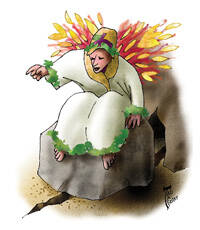Quaking With Joy
As the people of Japan, Christchurch and Haiti slowly rebuild their lives after suffering the devastating effects of earthquakes, a detail unique to Matthew’s account of the empty tomb catches one’s attention. The placid daybreak is shattered with “a great earthquake” (28:2), echoing the description of the aftermath of the death of Jesus found only in Matthew. Just after Jesus utters his final words and breathes his last, Matthew says, “The earth shook, and the rocks were split. The tombs also were opened, and many bodies of the saints who had fallen asleep were raised. After his resurrection they came out of the tombs and entered the holy city and appeared to many” (27:51-53).
While the earthquakes of our day cause massive loss of life by entombing people in the rubble of collapsed buildings, the earthquakes in the Gospel have the opposite effect: they split open tombs and raise to new life those held in the grip of death. They signal tectonic shifts made possible for humankind through God’s action in Christ.
Foremost is the shift away from paralyzing fear to an empowering joy. The angel’s first words to the women are, “Do not be afraid!” (v. 5). The centurion and those keeping watch over the crucified Jesus were terrified at the earthquake and what took place after his death (27:54), as were the guards at the tomb, who “were shaken with fear” so that they “became like dead men.” Not so Jesus’ disciples. The angel directs them away from seeking Jesus the crucified so that they can experience him as risen. God’s messenger invites them to come and see the place where he lay but then directs them to go out quickly. They are not to stay in the place of death. They are not to build a monument to the martyr Jesus and glorify his death but rather to announce and live the new life that bursts forth from the empty grave.
Harboring some fear, they follow the angel’s instructions and let joy overtake them. Then Jesus himself appears to them and reiterates his oft-repeated invitation to his disciples to let go the death-grip of fear (Mt 8:26; 10:26, 28, 31; 14:27; 17:7). They can move from fear to joy, when they come to know that Jesus never abandons his earthquaked people and that he is able to transform even the most brutal effects of violence. It is not only in this one definitive act of raising the crucified Christ that God’s life-giving power is exercised, but in every act of forgiveness and in every move toward reconciliation enacted by Jesus’ disciples.
Easter is not only about what happened to Jesus but, to a great degree, it is about what happens to us as we live lives that are transformed by his rising. In his letter to the Colossians, Paul speaks about Christians being so united with Christ that when he dies, we die with him. And when he is raised, so we too. We not only await final transformation but, every time we stand with the crucified peoples of our day, as did Mary Magdalene and the other Mary, the Risen One is alive in us as we break the hold of death-dealing powers even now.
The poet laureate Maya Angelou captures this sense in her poem, “Still I Rise,” as she speaks about the past horrors of an enslaved people: “Out of the huts of history’s shame/ I rise/ Up from a past that’s rooted in pain/ I rise/.../ Leaving behind nights of terror and fear/ I rise/ Into a daybreak that’s wondrously clear/ I rise/ Bringing the gifts that my ancestors gave,/ I am the dream and the hope of the slave./ I rise/ I rise/ I rise.”
This article also appeared in print, under the headline “Quaking With Joy,” in the April 18, 2011, issue.








